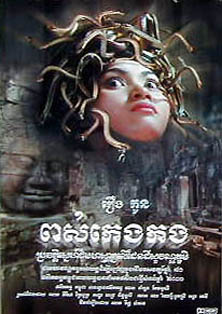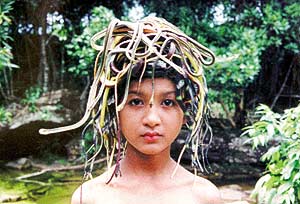 The Snake King’s Child (Khmer: រឿងកូនពស់កេងកង, Kuon puos keng kang, also Snaker and Ghost Wife 2) is a 2001 Cambodian-Thai horror film, based on a Cambodian myth about the half-human daughter of a snake god. It is the first full-length feature film to be produced in Cambodia since before the Khmer Rouge era. The special effect of the lead character’s head being full of writhing snakes was achieved by gluing live snakes to a cap worn by the actress.
The Snake King’s Child (Khmer: រឿងកូនពស់កេងកង, Kuon puos keng kang, also Snaker and Ghost Wife 2) is a 2001 Cambodian-Thai horror film, based on a Cambodian myth about the half-human daughter of a snake god. It is the first full-length feature film to be produced in Cambodia since before the Khmer Rouge era. The special effect of the lead character’s head being full of writhing snakes was achieved by gluing live snakes to a cap worn by the actress.
Plot
Neang Nhi (Ampor Tevy), a woman neglected by her abusive husband, Manop, is working in the fields one day when she accidentally loses her hoe in some shrubbery and encounters a giant python. The snake speaks to Nhi, and says he will return her hoe if she agrees to have sex with him. That night, the snake transforms into a man (Tep Rindaro), brings back the hoe, and has sex with Nhi, a union that results in Nhi’s pregnancy.
Manop eventually finds out that it was the python who impregnated his wife, so he beheads the python and then stabs his wife in the stomach. Nhi is killed by the blow, but dozens of small snakes pour out of her abdomen and into a nearby stream. Manop chases after the baby snakes, killing each one, but slips on a rock and is killed.
A surviving baby snake transforms into a human infant, who is then found by a wandering monk. The monk names the baby girl Soraya and raises her. She grows into a beautiful teenage woman (Pich Chanbormey), but has living serpents instead of hair. The monk, however, is able to fashion a magical ring that allows her to keep the snakes at bay and appear to have normal hair.
 One day, Soraya is bathing at a waterfall when she encounters a young man, Wae-ha (Winai Kraibutr), who has fallen into the pool after a fight with another man over a woman. Wae-ha is nursed back to health and he and Soraya fall in love. Wae-ha then takes Soraya back to his home to meet his family. One of Wae-ha’s friends attempts to rape Soraya, during which her ring comes off and the snakes appear in her hair and bite the man, killing him with their venom.
One day, Soraya is bathing at a waterfall when she encounters a young man, Wae-ha (Winai Kraibutr), who has fallen into the pool after a fight with another man over a woman. Wae-ha is nursed back to health and he and Soraya fall in love. Wae-ha then takes Soraya back to his home to meet his family. One of Wae-ha’s friends attempts to rape Soraya, during which her ring comes off and the snakes appear in her hair and bite the man, killing him with their venom.
It is further revealed that if Soraya’s virginity is broken, she will permanently turn into a snake.
Origins
The Snake King’s Child is a popular myth in Cambodia and has been depicted on film at least three times, one of the most famous being a 1960s version, Pos Keng Kang (Snake Woman) that starred Dy Saveth. In 2000, Cambodian director Fai Sam Ang decided it was time to try and make the first feature-length film in Cambodia since before the Khmer Rouge era, and he chose the oft-told tale in hopes that it would be a commercial success. The film was made as a co-production with investors from Thailand, and featured Thai leading man Winai Kraibutr, veteran Cambodian soap opera actress Ampor Tevy and 17-year-old debut Cambodian actress Pich Chanbormey.
Special Effects
 No digital effects are used in the film, as they could not be afforded by the production. To achieve the effect of Soraya’s head full of writhing snakes, live snakes were glued to a cap worn by actress Pich Chanboramey.
No digital effects are used in the film, as they could not be afforded by the production. To achieve the effect of Soraya’s head full of writhing snakes, live snakes were glued to a cap worn by actress Pich Chanboramey.
“Sometimes the snakes would leap off her head, and we’d have to chase them around the set,” director Fai Sam Ang said in an interview. He also said he had trouble convincing the actress to wear the cap. “When she first saw the snakes, she cried and cried,” Fai Sam Ang said. “But I told her she had to be professional. In the end, it was no problem. The snakes would just give her little kisses on the cheek.”
For another scene, a 4.5-meter python borrowed from a Buddhist temple was placed on top of actress Ampor Tevy to depict her character’s sex scene with the snake king.
Release
At the time of the film’s release, war-ravaged Cambodia did not yet have any commercial cinemas suitable to premiere the film, so it was screened at the French Cultural Center and outdoors in the courtyard of a local television station in Phnom Penh. The film also opened in wide release in Thai cinemas.
Due to Winai Kraibutr’s presence in the cast, the film was marketed in Hong Kong and other Asian markets as Ghost Wife 2 in an attempt to cash in on the popularity of the 1999 Thai ghost film Nang Nak (Ghost Wife), which Winai had starred in.
Reviews
One of the first films made in Cambodia since the Khmer Rouge, Snaker (the regrettable Hong Kong DVD version english title of the film, far less eloquent than the translated Cambodian title, The Snake King’s Child) is a landmark in the cultural redevelopment of the country, and, it is hoped, the beginning of a revival of the film industry. A co-production with Thailand, it features both Cambodian and Thai actors together. The film was released in Thai theaters in March, but since there are no movie theaters in Cambodia, it’s release has been limited to showings in parks, meeting halls, and the like. Still, many Cambodians have seen the film, since it is readily available on bootleg VCDs throughout the country.
The director, Fay Sam Ang, hoped to continue to produce films after this first one. However, since this film only barely covered costs through sales of rights to other asian countries, and bootlegging has pretty much put to an end any additional earnings, they may not be producing more films soon. Time will tell.
The Snake King’s Child is another retelling of the classic Cambodian folktale, of which three prior versions, including The Snake Girl, have already been made. This time around, the plot (or what I could make of it in this unsubtitled production), concerns a peasant woman, Neang Ni (Om Portevy), and her abusive, jealous, drunken husband. He goes off to the market for long periods of time and does not return. On one of his trips, Neang Ni drops her hoe in the bushes, where a giant python is hiding. The python speaks to her, and allows her to reclaim her hoe, provided she become his wife. That night, the python enters her hut and transforms into a man wearing a terribly tacky glittery rayon disco outfit (Tep Rindaro). They make love, and when she wakes up, she is butt naked, in bed, next to a giant python. She is frightened for a moment, then thinks back about the guy in rayon and starts getting all hot again. Next thing you know she picks up the giant snake and starts cradling it, kissing it, and stroking it. Freudians, it is safe to come back into the room now.
Soon enough, she is pregnant with the Snake King’s child. She hides it from her husband as long as possible, but soon it becomes impossible, and one day when she is out bathing, he clearly sees she is pregnant. Enraged, he forces her to eat some herbs to cause an abortion, but it fails. Then their daughter tells the husband that it is the python who impregnated her. He cuts off the python’s head and dangles the corpse in front of his wife. Still, he has not done enough. He stabs her in the stomach to kill her and her child, but instead, dozens of little snakes pour out of the wound. He rushes after them, killing each one, but then, when trying to kill the last, runs into a stream, slips on a rock, and dies. The young daughter sees both her parents dead, rushes out onto the rocks, and sure enough, slips, hits her head, and dies, too. The little snake meanwhile transforms into a baby, which a wandering monk happens upon. Seeing the child’s significance, he takes her up, names her Soriya, and raises her himself until she is a beautiful teenager (Pich Cham Bormey). Beautiful, that is, except for the living serpents she has for hair.
But the tragedy is only the first act, with the second, inevitably, a love story. A subtitle, the only one in English, proudly declares, “Over passed 10 years.” And now, there is a love triangle between two young men and a beautiful, but spoiled, woman named Ranee. They constantly vie for her attention and affection. A fight between the two men ends with one of them falling off of a waterfall into the pool below. Thinking him dead, the other man and Ranee rush away, preparing a story to make up to their parents as to what happened. But of course, he is not dead, and Soriya fishes her out of the drink and brings her to the monk. Before he revives, the monk decides it’s a good time to give Soriya a magic ring which makes her look human, with the admonition that, should she lose her virginity, she would become a snake forever.
When the young man, Wae-ha (Winai Kraibutra) awakes, he sees Soriya bathing and immediately falls in love. They stay together with the monk until he is fully recovered, then they return together to his estate to meet his old, lifelong friends. Renee is happy to see him, since she always liked Wae-ha better, but none to happy to see her. His friend, on the other hand, also becomes infatuated with the newcomer. At first Renee puts the moves on Wae-ha again, but with no results. They try to trick him into hating her, again without effect. At last, his buddy decides to rape her, but her magic ring comes off and one of her snakes bites him. The poisonous venom kills him instantly.
Wae-ha and Soriya leave the family estate then, and visit Angkor Wat. Not for any particular reason, as far as I can tell. But what the heck — when you’re filming in Cambodia, it seems a shame NOT to set a few scenes there. One of the world’s most fantastic set backdrops, and you don’t have to construct a thing. Anyway, under the watchful Buddhas of Angkor Thom they profess their undying love for one another and jump in the sack. Or, the grassy clearing, as the case may be. In the morning, Soriya notices scales growing all over her and runs back to the monk, begging for his help. But the nasty woman Renee and her grandmother, who apparently is a witch (go figure), show up, and the witch and the monk duel to the death. The Snake King’s Child would not be true to the spirit of the original tale if it didn’t have a happy ending, and so it does. After all, some good karma has to come from all that bloodshed at the beginning of the picture.
The Snake King’s Child is for the most part a Cambodian picture, with Om Portevy (or Ampor Tevy, depending on how you Romanize the name), a popular Cambodian soap opera star, featured. But it also features Winai Kraibutra, a well-regarded Thai actor, who recently appeared in the internationally successful Thai film Nang Nak, which was also an old folktale brought to new life. (Fans of Winai will enjoy his gratuitous butt shot midway through the picture). The actor is a considerable draw, making the picture a success in Thailand, which at least has movie theaters. Another big draw for the film is its soundtrack, a compilation of modern Khmer-pop hits. The music was enjoyable to listen to, I thought, and did much to improve the overall quality of the production.
There is one special effect of note, and it’s a remarkable one. The young Soriya’s slithering hair was achieved by taping a dozen snakes to a wig which was fitted on the actresses head. The snakes all move independently of one another, and are just mesmerizing to watch. No digital effect could ever have conveyed how such a thing actually looks.
Try to find this film if you can, and see the rebirth of a national cinema. It may not be much to look at, but it is a new beginning.
Cast and Crew
Directed by: Fai Sam Ang
Produced by: Thunya Nilklang
Written by: Fai Sam Ang, Mao Samnang
Starring: Winai Kraibutr
Pich Chanbormey
Ampor Tevy, Tep Rundaro
Cinematography: Saray Chan
Distributed by: Siam Film Development, Studio Bangkok, Winson (Hong Kong)
Release date(s): February 2001, March 2001
Country: Cambodia, Thailand
Language: Khmer
Preceded by The Snake King’s Wife Part 2
Followed by The Snake King’s Grandchild
